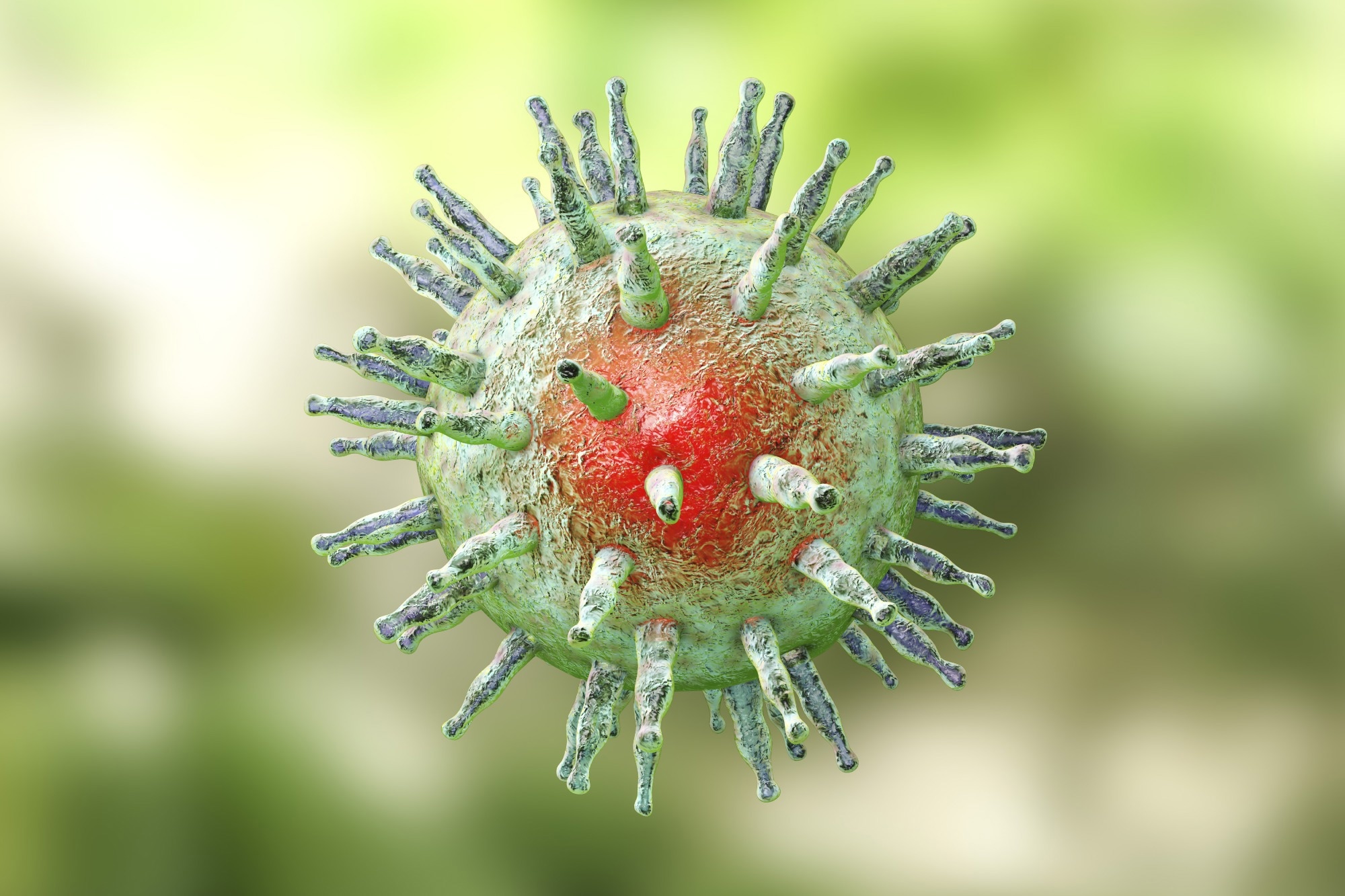Scientists from Australia and the USA have developed a lymph node-targeted multi-epitope subunit vaccine that induces strong humoral and cellular immune responses against Epstein-Barr virus (EBV) in mice. The study is published in the journal Nature Communications.
 Study: Lymph node targeted multi-epitope subunit vaccine promotes effective immunity to EBV in HLA-expressing mice. Image Credit: Kateryna Kon/Shutterstock.com
Study: Lymph node targeted multi-epitope subunit vaccine promotes effective immunity to EBV in HLA-expressing mice. Image Credit: Kateryna Kon/Shutterstock.com
Background
Epstein-Barr virus (EBV) is a ubiquitous herpesvirus, infecting approximately 95% of the global population. The virus infects resting B cells in the oropharynx and induces transcriptional programming of these cells to establish life-long viral latency.
In adults, EBV can induce the development of symptomatic infectious mononucleosis, which is a major risk factor for multiple sclerosis and Hodgkin lymphoma. In addition, EBV infection is associated with the development of multiple lymphoid and epithelial cancers worldwide.
In this study, scientists have developed a lymph node-targeting multi-epitope subunit vaccine against EVB and tested its efficacy in Human Leukocyte Antigen (HLA)-expressing mice.
Vaccine design
Scientists analyzed known human CD8+ T cell epitopes from EBV antigens to design a polyepitope vaccine immunogen that incorporates 20 CD8+ T cell epitopes into an engineered protein immunogen.
They identified highly-conserved antigenic peptide sequences from a range of latent and lytic EBV proteins and included them serially by separating each sequence using proteolytic cleavage sites. This gave rise to a “beads on a string”-type structure.
The peptide epitopes were restricted through several common HLA class I alleles for broader coverage across many ethnic groups. The inclusion of both latent and lytic antigenic epitopes is intended to induce robust T-cell response targeting different phases of the viral life cycle.
The polypeptide vaccine immunogen was admixed with whole recombinant EBV glycoprotein 350 (gp350) to generate a virus-specific neutralizing antibody response. A robust humoral immunity together with T cell immunity is expected to promote strong prophylactic activity combined with persistent control of EBV latency.
To further increase vaccine-induced immune response, an Amphiphile-modified CpG DNA adjuvant was incorporated into the vaccine. This adjuvant was designed to increase lymph node delivery and accumulation of vaccine antigen and adjuvant.
Vaccine validation
The testing of the polyepitope vaccine immunogen using peripheral mononuclear cells isolated from EBV seropositive donors revealed that the immunogen can be effectively processed by antigen-presenting cells to generate epitopes that can be presented on HLA class I molecules and subsequently recognized by human CD8+ T cells to promote an immune response.
The testing of lymph node accumulation of vaccine immunogens revealed that the Amphiphile-modified CpG DNA adjuvant is highly capable of increasing lymph node drainage and retention of immunogens, in addition to persistently inducing an acute inflammatory response in local and distal lymph nodes.
Vaccine-induced cellular immunity
The immunogenicity of the vaccine was tested using HLA-expressing transgenic mice. The mice were immunized with the primary vaccine dose, followed by two booster doses, each three weeks apart. Vaccination with soluble CpG instead of Amphiphile-CpG was carried out for comparative analysis.
The findings revealed that vaccination with Amphiphile-CpG adjuvant induces significantly higher viral antigen-specific cytokine-producing CD8+ T cells compared to vaccination with soluble CpG. The Amphiphile-CpG vaccine-induced T cells exhibited robust polyfunctional effector phenotype. Moreover, vaccination with Amphiphile-CpG induced three times more gp350-specific cytokine-producing CD4+ T cells than soluble CpG.
A dramatic expansion of viral antigen-specific CD8+ T cells with robust polyfunctional effector phenotype was observed in splenocytes of mice immunized with Amphiphile-CpG vaccine. This response was significantly lower in mice immunized with soluble CpG. A similar trend was observed for CD4+ T cell response.
Vaccine-induced humoral immunity
The analysis of gp350-specific B cell response in immunized mice revealed that both Amphiphile-CpG and soluble CpG induce comparable numbers of antibody-secreting B cells in splenocytes.
The analysis of memory B cell response revealed that Amphiphile-CpG induces higher numbers of memory gp350-specific antibody-secreting B cells compared to soluble CpG. This indicates that the Amphiphile-CpG adjuvant is associated with increased memory B cell response.
Both Amphiphile-CpG and soluble CpG induced robust gp350-specific immunoglobulin G (IgG) response 3 weeks post-vaccination. However, a significantly higher IgG response was observed at weeks 4 and 7 in mice immunized with Amphiphile-CpG compared to those immunized with soluble CpG.
Regarding virus-neutralizing immunity, the findings revealed that immunization with Amphiphile-CpG induces 100 times more neutralizing antibody titers compared to soluble CpG. Further analysis revealed that Amphiphile-CpG immunization is capable of inducing long-lived CD8+ and CD4+ T cell responses.
Similarly, Amphiphile-CpG immunization exhibited high efficacy in inducing robust neutralizing antibody response that lasted for at least 7 months and was rapidly boosted after subsequent exposure to vaccine immunogens.
Protective efficacy against EBV-induced B cell lymphoma
The protective efficacy of the vaccine-induced immune response was assessed by treating EBV-induced B lymphoma-carrying mice with polyepitope vaccine immunogen-stimulated T cells with or without gp350-specific antibodies.
The findings revealed that vaccine immunogen-induced persistent T-cell response with or without virus-specific antibodies is capable of effectively preventing the spread of EBV-induced lymphoma in mice.